Nicola Cornick's Blog, page 34
March 4, 2011
Elizabethan Honey Cake
As it's Friday and everyone deserves a treat, I'm posting up a 16th century recipe for the most delicious Elizabethan Honey Cake. I first came across this at the National Trust house  Moseley Old Hall, where it is served in the tearoom. Enjoy!
Moseley Old Hall, where it is served in the tearoom. Enjoy!
Ingredients:
6oz butter or margarine, 6oz caster sugar, 60z self-raising flour, 1 teaspoon baking powder, 1 tablespoon of clear honey, 3 eggs, almond essence, lemon icing (optional).
Method:
Cream the butter and sugar together. Slowly add the eggs and a small amount of the flour. Add the honey, baking powder and a few drops of almond essence. Fold in the rest of the flour. Spoon into a 6 inch cake tin lined with greaseproof paper. Cook in a moderate oven (190 degrees/gas mark 5) for about 35 minutes. Test with a fine skewer to see if it comes out clean. Allow to cool on a wire rack and if you wish, top with lemon icing when quite cold. Serve with a pot of tea, eat and enjoy!
©2011 Nicola Cornick. All Rights Reserved.
.March 2, 2011
What sort of books does your dog enjoy?
Here's a story for you, Barb, and all the other dog-lovers amongst us! Yesterday I read in the paper about Danny, a greyhound, who visits a school in Staffordshire as a "listening dog."  Danny is part of a scheme that originated in the US called Reading Education Assistance Dogs which is designed to encourage young children to read aloud. "When children read to him, Danny does not criticise or correct their pronunciation," the article said. "He just nods and pricks up an ear, although sometimes he closes his eyes and appears not to be listening." (I think Danny is imagining himself right there in the story.) The scheme helps children develop their self-esteem in reading out loud because Danny is non-judgmental and never laughs at them. Many of the children show him the pictures in the book as they go along.
Danny is part of a scheme that originated in the US called Reading Education Assistance Dogs which is designed to encourage young children to read aloud. "When children read to him, Danny does not criticise or correct their pronunciation," the article said. "He just nods and pricks up an ear, although sometimes he closes his eyes and appears not to be listening." (I think Danny is imagining himself right there in the story.) The scheme helps children develop their self-esteem in reading out loud because Danny is non-judgmental and never laughs at them. Many of the children show him the pictures in the book as they go along.
Danny had to train for five months to be a Listening Dog. Greyhounds are apparently well suited to being Listening Dogs because they don't bark and their short coats don't tend to trigger allergies. Here's Danny in the picture and you can see he is listening intently.
 I think this is wonderful. My dog Monty frequently gets cast in the role of Listening Dog whether he likes it or not, usually when I'm pacing the floor trying to get a particular plot point or piece of dialogue right. He never complains, watches me intently, but occasionally rolls over and goes to sleep with a big sigh when he thinks I've been going on long enough. I think he'd make a great official Listening Dog but for the fact that he will bark when he sees a picture of a cat. Here is Monty listening to me reading to him from one of my books…
I think this is wonderful. My dog Monty frequently gets cast in the role of Listening Dog whether he likes it or not, usually when I'm pacing the floor trying to get a particular plot point or piece of dialogue right. He never complains, watches me intently, but occasionally rolls over and goes to sleep with a big sigh when he thinks I've been going on long enough. I think he'd make a great official Listening Dog but for the fact that he will bark when he sees a picture of a cat. Here is Monty listening to me reading to him from one of my books…
If you were going to read to a Listening Dog, what book would you choose? And what sort of dog do you thing would make the best listener?
©2011 Nicola Cornick. All Rights Reserved.
.March 1, 2011
The Lost Battle
Today over on the Ashdown House blog I'm talking about the location of the Battle of Ashdown, and King Alfred the Great's famous victory over the Vikings. Where was the site of the battle? 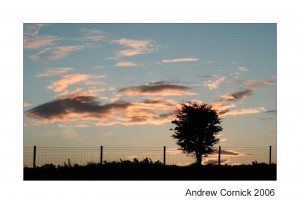 Yes, you guessed it – in my back garden! (Well, almost…)
Yes, you guessed it – in my back garden! (Well, almost…)
©2011 Nicola Cornick. All Rights Reserved.
.February 28, 2011
Blogging with Mia Marlowe!
 Please join me today at the blog of fabulous author Mia Marlowe! We're talking travel, dogs and historical inspiration. There is also a copy of Lord of Scandal up for grabs!
Please join me today at the blog of fabulous author Mia Marlowe! We're talking travel, dogs and historical inspiration. There is also a copy of Lord of Scandal up for grabs!
©2011 Nicola Cornick. All Rights Reserved.
.February 24, 2011
Dancing in a Regency ballroom
Last weekend I was in Dorset, a county that can provide a lot of inspiration for a Regency author with the seaside spa of Lyme Regis and the Jurassic coastline so beloved of the 19th  century fossil hunters. We were staying in the town of Bridport, at The Bull Hotel, a fabulous seventeenth century coaching inn complete with sloping floors, low ceilings and lashings of historical atmosphere. You may imagine my excitement when I discovered that The Bull had a ballroom that had been in use in the Georgian and Regency period for those local balls and assemblies we read about in books such as Pride and Prejudice where Lizzy Bennet first set eyes on Mr Darcy. Relatively small ballrooms like this were an important part of the social life of a country town and I had never seen one before but it was just like a scaled down version of the Assembly Rooms in a city like Bath. Here the local gentry families would come to mingle and of course the attendance of a party of newcomers such as Mr Bingley and his sisters and Mr Darcy would cause huge excitement!
century fossil hunters. We were staying in the town of Bridport, at The Bull Hotel, a fabulous seventeenth century coaching inn complete with sloping floors, low ceilings and lashings of historical atmosphere. You may imagine my excitement when I discovered that The Bull had a ballroom that had been in use in the Georgian and Regency period for those local balls and assemblies we read about in books such as Pride and Prejudice where Lizzy Bennet first set eyes on Mr Darcy. Relatively small ballrooms like this were an important part of the social life of a country town and I had never seen one before but it was just like a scaled down version of the Assembly Rooms in a city like Bath. Here the local gentry families would come to mingle and of course the attendance of a party of newcomers such as Mr Bingley and his sisters and Mr Darcy would cause huge excitement!
 Not only was the ballroom at The Bull still recognisably a Regency assembly room but there was also a refreshment room next door (now a cocktail bar), a little withdrawing room for the ladies and a private stair by which the guests could enter the ballroom without having to go through the taproom and less salubrious parts of the inn. I found it easy to slip back in time as I sat sipping my cocktail, and imagined the room full of young ladies in their finery, their matchmaking mamas in tow, and gentlemen in evening dress or uniform… I've posted a couple of photos of the ballroom and refreshment room
Not only was the ballroom at The Bull still recognisably a Regency assembly room but there was also a refreshment room next door (now a cocktail bar), a little withdrawing room for the ladies and a private stair by which the guests could enter the ballroom without having to go through the taproom and less salubrious parts of the inn. I found it easy to slip back in time as I sat sipping my cocktail, and imagined the room full of young ladies in their finery, their matchmaking mamas in tow, and gentlemen in evening dress or uniform… I've posted a couple of photos of the ballroom and refreshment room 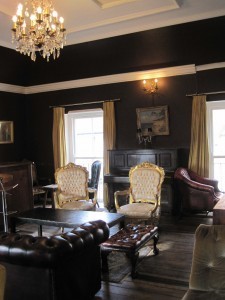 here for anyone interested in seeing what a small assembly room in a country town would look like. Apologies that the ballroom pic is a little skew whiff. I was using the wide angle and standing on some steps – and that was after the cocktails!
here for anyone interested in seeing what a small assembly room in a country town would look like. Apologies that the ballroom pic is a little skew whiff. I was using the wide angle and standing on some steps – and that was after the cocktails!
The Bull has an interesting and chequered history. On 14th June 1685, the Duke of Monmouth's forces attacked the King's militia in Bridport. Colonel Venner was shot and wounded by the King's militia from a now bricked-up window of The Bull Hotel. The cocktail bar is named The Venner Room in recognition of this event. A flagstone in the church, set in the chancel floor, also commemorates a William Harvey of Wyke, who died of wounds received at The Bull while fighting with King James's militia during this first shoot-out of Monmouth's rebellion.
Across the street from The Bull was the Old George Inn, now a shop, with lettering around the top that records a visit there by King Charles II on September 3rd 1651 after his defeat at the Battle of Worcester. Charles was apparently almost captured there by Cromwell's troops. The Old George Inn was converted into a pharmacy in the early nineteenth century by Dr Giles L Roberts who developed a popular ointment called "The Poor Man's Friend," the recipe for which is in the Bridport Museum. Bridport has a fascinating history and, perhaps inevitably for a town so close to the South Coast, a history of smuggling in the Georgian period. I loved my visit and the discovery of so many extant Regency features at The Bull, from the ostlers' room to the ballroom, really made my weekend!
©2011 Nicola Cornick. All Rights Reserved.
.February 21, 2011
Winners and Bloggers!
Thank you to everyone for your imaginative suggestions in the "build your own castle" discussion! The winner was Sue, with her Widow's Walk and Gothic atmosphere! Congratulations,  Sue!
Sue!
Today I am hosting historical author Christina Courtenay over on the Word Wenches Blog. Christina is talking about the fascinating 17th century Japanese background to her new book, The Scarlet Kimono. And there is still a castle theme – come over and share with us your favourite castles for the chance of winning a copy of The Scarlet Kimono!
©2011 Nicola Cornick. All Rights Reserved.
.February 17, 2011
Not quite what it seems…
Last weekend I was lucky enough to have a quick visit back to the New Forest to stay in a cottage on the estate of the magnificent Rhinefield House Hotel. On the Saturday afternoon we  wandered around the fabulous grounds before heading off for a delicious afternoon tea. The magnificent mansion Rhinefield House, with its pretty Tudor chimneypots is something to behold. But I hadn't been beholding it for very long before I suspected that it wasn't quite all it seemed – unless it had been built from the Tudor chimneys downwards! There was something definitely Victorian Gothic about the turrets and the medieval windows and machicolations, and never before had I seen a stately home with such a huge cathedral-style window and two darling little arched cloister-style walkways on the first floor! So I went away to find out about the history of the house and turned up some fascinating information.
wandered around the fabulous grounds before heading off for a delicious afternoon tea. The magnificent mansion Rhinefield House, with its pretty Tudor chimneypots is something to behold. But I hadn't been beholding it for very long before I suspected that it wasn't quite all it seemed – unless it had been built from the Tudor chimneys downwards! There was something definitely Victorian Gothic about the turrets and the medieval windows and machicolations, and never before had I seen a stately home with such a huge cathedral-style window and two darling little arched cloister-style walkways on the first floor! So I went away to find out about the history of the house and turned up some fascinating information.
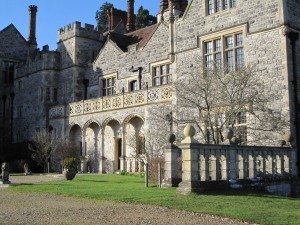 The house in its current form was built in the 1880s by the Walker-Munros. Mrs Mabel Walker-Munro had been an heiress whose father had made his money in coal and had given his daughter £250 000 as a wedding present to build a mansion. In addition to the main house there is a hunting lodge, stables, gardener's bothy and gate lodge, all in a somewhat eclectic range of styles. (We were staying in the converted greenhouses beside the gardener's bothy!) In the main house Mrs Walker-Munro created four suites of rooms for the four daughters she was planning to produce. Unfortunately Nature did not oblige and instead of the four daughters she had only one son!
The house in its current form was built in the 1880s by the Walker-Munros. Mrs Mabel Walker-Munro had been an heiress whose father had made his money in coal and had given his daughter £250 000 as a wedding present to build a mansion. In addition to the main house there is a hunting lodge, stables, gardener's bothy and gate lodge, all in a somewhat eclectic range of styles. (We were staying in the converted greenhouses beside the gardener's bothy!) In the main house Mrs Walker-Munro created four suites of rooms for the four daughters she was planning to produce. Unfortunately Nature did not oblige and instead of the four daughters she had only one son!
Of the curious architectural style of the house, an article in Southern Life states: "The Great House… incorporates a mixture of styles, both  externally and internally, reflecting the personal tastes which the Walker-Munros acquired on their travels. Thus Tudor combines with Gothic architecture whilst inside, the Great Hall has many features of the Westminster Hall and the Master's Smoking Room reproduces the splendour of the Alhambra Palace in Granada. Opinions on this mixture vary…" Quite! "The Alhambra Room alone took the Spanish workmen, who were brought over specifically for the purpose, two years to build. Other notable features are the Armada carving by Aumonnier with a surrounding by Grinling Gibbons, a ceiling canvas by Fragonnard, the magnificent wood panelling throughout the house and the Orchestration, which occupies the organ loft in the Grand Hall." Phew! As a piece de resistance, the Walker-Munros also built a huge "beach hut" at nearby Milford-on-Sea with a bridge and upper deck in the style of an ocean liner! Anyone looking for a model for the Victorian heiress with lots of money and… questionable… taste need look no further!
externally and internally, reflecting the personal tastes which the Walker-Munros acquired on their travels. Thus Tudor combines with Gothic architecture whilst inside, the Great Hall has many features of the Westminster Hall and the Master's Smoking Room reproduces the splendour of the Alhambra Palace in Granada. Opinions on this mixture vary…" Quite! "The Alhambra Room alone took the Spanish workmen, who were brought over specifically for the purpose, two years to build. Other notable features are the Armada carving by Aumonnier with a surrounding by Grinling Gibbons, a ceiling canvas by Fragonnard, the magnificent wood panelling throughout the house and the Orchestration, which occupies the organ loft in the Grand Hall." Phew! As a piece de resistance, the Walker-Munros also built a huge "beach hut" at nearby Milford-on-Sea with a bridge and upper deck in the style of an ocean liner! Anyone looking for a model for the Victorian heiress with lots of money and… questionable… taste need look no further!
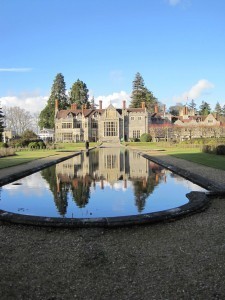 Just for fun I tried to channel Mabel Walker-Munro and imagine what I would do with the modern day equivalent of her £250 000 and the need to build my own country pile. I decided I would go for a black and white timbered moated manor (it absolutely has to have a moat!) with full deer park, a folly on a nearby hill and a medieval dovecote. What about you? If you were building your own stately home would you go for the full Cinderella style turrets or the classic elegance of the Regency – or a combination of the two?! There's a backlist book on offer for the most imaginative idea!
Just for fun I tried to channel Mabel Walker-Munro and imagine what I would do with the modern day equivalent of her £250 000 and the need to build my own country pile. I decided I would go for a black and white timbered moated manor (it absolutely has to have a moat!) with full deer park, a folly on a nearby hill and a medieval dovecote. What about you? If you were building your own stately home would you go for the full Cinderella style turrets or the classic elegance of the Regency – or a combination of the two?! There's a backlist book on offer for the most imaginative idea!
©2011 Nicola Cornick. All Rights Reserved.
.February 14, 2011
Owner of a Lonely Heart!
Recently I've been reading up about the history of lonely hearts advertising and I was astonished to discover that the first adverts to find husbands and wives appeared way back in the 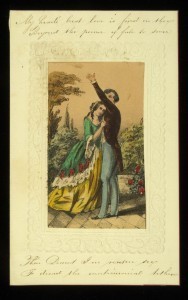 1690s! By the early 18th century, matrimonial advertising, as it was called, was booming with the expansion of newspapers, periodicals and pamphlets. These days people may be looking for a good sense of humour but back in those days it was money that was the driving force behind the advertisements. Here is one from 1750:
1690s! By the early 18th century, matrimonial advertising, as it was called, was booming with the expansion of newspapers, periodicals and pamphlets. These days people may be looking for a good sense of humour but back in those days it was money that was the driving force behind the advertisements. Here is one from 1750:
"A Gentleman Desirous of Marriage. Gentleman, 25 years of age and of a healthful constitution, is desirous of altering his condition, by marrying a young lady (or widow who has no child) and can make a jointure proportionable to 8000 or 10000 pounds. Advertisements of this kind are often inserted by gentlemen for their diversion. I do therefore declare myself in earnest and the real foundation of applying in the public way is a want of acquaintance in London sufficient to introduce me in a private one."
Certainly no mention of love and not even companionship, and women who already have children need not apply! So far so practical. Another man was even more blunt:
"A young man wants a wife with two or three hundred pounds; or the money will do without the wife." What a charmer! Next!
 There was surprisingly little emphasis placed on physical characteristics. A few adverts asked for "a good physiognomy" or "pleasing figure" but that was as far as it went. One advertisement from 1770 specifying "shapely ankle preferred" was uncharacteristically frisky. The ladies were, perhaps predictably, much more romantic in their requirements, with one young lady seeking a man "of fashion, honour and sentiment, blended with good nature and a noble spirit." Another, more practical or perhaps with more experience of men's failings, specified: "He must never drink above two bottles of claret or one of port at a sitting, and that but three times a week."
There was surprisingly little emphasis placed on physical characteristics. A few adverts asked for "a good physiognomy" or "pleasing figure" but that was as far as it went. One advertisement from 1770 specifying "shapely ankle preferred" was uncharacteristically frisky. The ladies were, perhaps predictably, much more romantic in their requirements, with one young lady seeking a man "of fashion, honour and sentiment, blended with good nature and a noble spirit." Another, more practical or perhaps with more experience of men's failings, specified: "He must never drink above two bottles of claret or one of port at a sitting, and that but three times a week."
Let's hope all these practical gentlemen were able to find someone to love as well as to provide them with a fortune and that the ladies were not disappointed in their choices!
Happy Valentine's Day!
©2011 Nicola Cornick. All Rights Reserved.
.February 11, 2011
The Ultimate Romantic Gesture!
Have you ever wished that your beloved would, in the ultimate romantic gesture, build you the house of your dreams? Or would that be a bit over the top? Ashdown House is a Valentine's Day gift in bricks and mortar (or chalk, actually), a house built by the Earl of Craven for the love of a woman who never lived to see it – Elizabeth of Bohemia, The Winter Queen. On Elizabeth's return to England from exile in 1661 the Earl of Craven, knowing of her desire to live quietly in the country, commissioned not one but two houses for her pleasure. The first, Hamstead Marshall, was designed to mirror Elizabeth's palace in Heidelberg. The second, Ashdown, was a hunting lodge so that Elizabeth could continue to pursue her lifelong passion for hunting.
In  honour of the approach of St Valentine's Day, the fascinating blog lostpastremembered, which marries food and history, has posted a piece about William, Elizabeth and Ashdown. As well as detailing the Earl of Craven's devotion to his lady over the course of forty years, the blog piece gives a wonderful insight into all things culinary from the period, from the way the table would be laid for a banquet at Elizabeth and Frederick of Bohemia's castle in Heidelberg, to a stunning recipe for Raspberry Sauce with Port to complement the romance of the story. You can read the whole post here - and make the dessert as well if you wish!
honour of the approach of St Valentine's Day, the fascinating blog lostpastremembered, which marries food and history, has posted a piece about William, Elizabeth and Ashdown. As well as detailing the Earl of Craven's devotion to his lady over the course of forty years, the blog piece gives a wonderful insight into all things culinary from the period, from the way the table would be laid for a banquet at Elizabeth and Frederick of Bohemia's castle in Heidelberg, to a stunning recipe for Raspberry Sauce with Port to complement the romance of the story. You can read the whole post here - and make the dessert as well if you wish!
I'll be back on Valentine's Day to chat about historical lonely hearts advertisements. In the meantime, have a lovely weekend!
©2011 Nicola Cornick. All Rights Reserved.
.February 10, 2011
What can my dog see that I can't?
Last week on Facebook I commented on how Monty, my dog, had suddenly taken to spooking me on our evening walks. We have two routes we travel and on the evenings that we walk 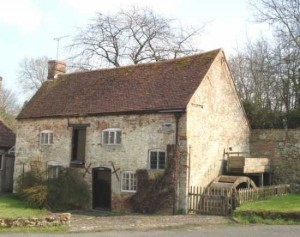 through the village we wander slowly along, Monty checking out each post and stone for interesting scents and me looking at the stars or, more often, huddling inside my waterproof coat. My village is tiny; the road meanders past a number of ancient cottages, dips into a little hollow beside the old mill ( the one in the picture on the right) and then starts to climb again, bridging the mill stream as it heads out towards the main road. There are no street lights out here in our corner of Oxfordshire and at night it's not uncommon for the only sounds to be the rushing of the water and the call of the owls. What light there is comes from the moon, stars and the cottage windows and outside lights.
through the village we wander slowly along, Monty checking out each post and stone for interesting scents and me looking at the stars or, more often, huddling inside my waterproof coat. My village is tiny; the road meanders past a number of ancient cottages, dips into a little hollow beside the old mill ( the one in the picture on the right) and then starts to climb again, bridging the mill stream as it heads out towards the main road. There are no street lights out here in our corner of Oxfordshire and at night it's not uncommon for the only sounds to be the rushing of the water and the call of the owls. What light there is comes from the moon, stars and the cottage windows and outside lights.
Until last autumn our evening walks had proceeded without any strange occurences at all. Then, as the nights drew in as we approached Halloween, Monty and I started to see what we both thought was a cat. It was small, dark, shadowy and oddly insubstantial and it would dash across the road in front of us and disappear under a parked car. Monty would try to rush after it but it was never actually there; we'd both peer around and look under the car and try to see where it had gone, but it had vanished. There's nothing odd in a disappearing cat, though, especially when it sees a dog approaching. What baffled us was that we never actually saw where it went, but of course it was dark… We continue to see the cat quite often.
Then one evening at exactly the same point in the road, where it dips down to pass the old mill, we saw the vanishing man. That was more disturbing. We saw him walking towards us as we approached. He wasn't anyone I recognised (in a place as small as this you know all the neighbours) and at that time of the evening on a cold night it was odd seeing a stranger wandering about without a coat. He was tall, dark and thin, and he crossed the road in front of us. Monty, a very mild-mannered dog normally, barked at the stranger. His hackles came up and he refused to move. And then the figure disappeared – literally faded out as it was walking away - and we both stood still, in my case because I was so surprised.
 The oddest thing that has happened down there by the mill, though, was an enormous shadow that reared up behind us as we were walking and looked like a breaking wave about to tumble over us. That was the only time I felt scared, and then only because there was an odd atmosphere that night with definitely a hint or more of malevolence in the air.
The oddest thing that has happened down there by the mill, though, was an enormous shadow that reared up behind us as we were walking and looked like a breaking wave about to tumble over us. That was the only time I felt scared, and then only because there was an odd atmosphere that night with definitely a hint or more of malevolence in the air.
Last week we reached the mill on our nightly walk and Monty stopped dead and could only be coaxed on after a minute or two with a hefty bribe of biscuits. He very carefully walked around something in the road that I couldn't see. But last night he dug his paws in and we had a flat-out refusal and for the first time we had to turn around and come home. I'm wondering what tonight will bring. Perhaps we need to find a new route for our nightly walk. And I wish I could see what Monty can see!
There are many, many places in the world that can lay claim to some sort of haunting and this village, which is recorded even before the Domesday Book of 1086 certainly has enough history behind it to have left an imprint on the place. That's how I like to think of it, as memories of the people – and cats! – and emotions and experiences that, over the hundreds of years, have left their mark on a place. Sometimes you can feel it in the air. Sometimes you can see traces. I can't explain it but most of the time I don't mind living alongside it and have done here, and in our haunted cottage in Somerset, and in various other places. Shakespeare got it right, I think: There are more things in heaven and earth than are dreamt of in our philosophy. What do you think?
©2011 Nicola Cornick. All Rights Reserved.
.


